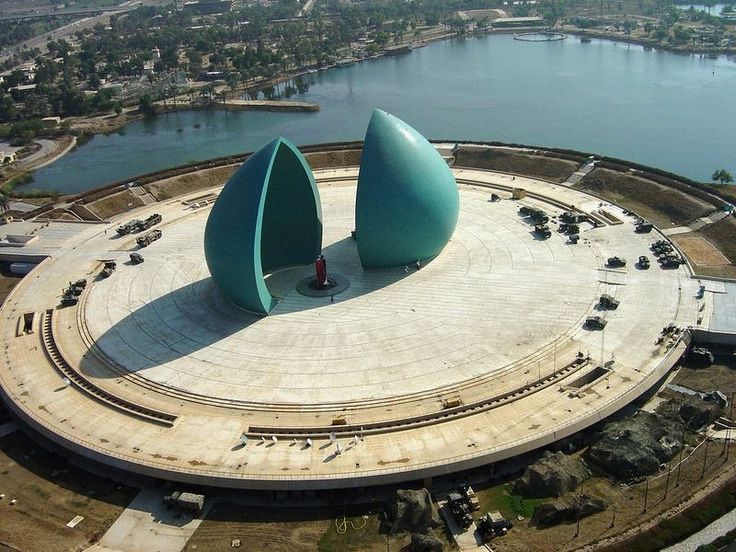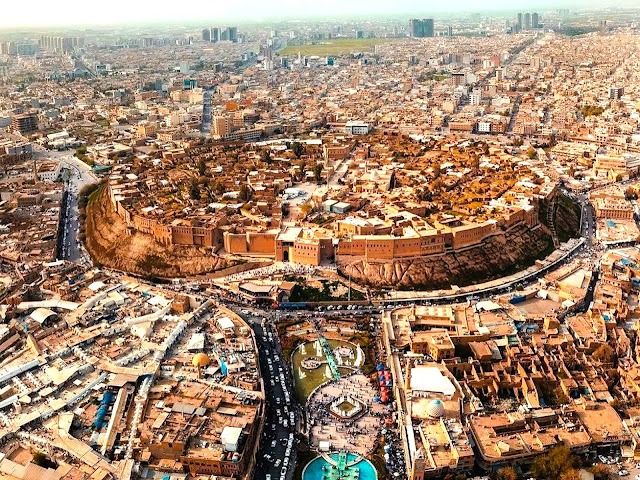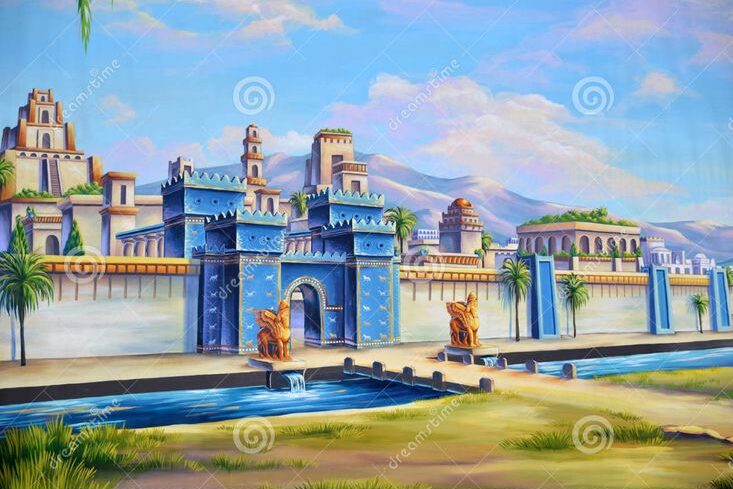Best Place To Travel In Iraq
1.The capital of Iraq is Baghdad
Al-Shaheed Monument (Martyr's Monument)

Iraq is a country with a deep and ancient history, often referred to as the “Cradle of Civilization” due to its location in Mesopotamia, where some of the earliest known human societies emerged. Home to the Sumerians, Babylonians, and Assyrians, Iraq’s contributions to writing, law, and architecture are foundational to human history. The country is rich in cultural and religious diversity, with a landscape that ranges from the fertile plains of the Tigris and Euphrates rivers to the vast deserts and mountainous regions. Despite facing significant challenges, including decades of conflict, Iraq remains a nation of profound cultural heritage and a resilient spirit.
Baghdad, the capital of Iraq, is a city steeped in history and culture, known as one of the most significant centers of the ancient and medieval Islamic world. Founded in the 8th century by the Abbasid Caliphate, it quickly became a hub of learning, trade, and art, earning the nickname “City of Peace.” Baghdad’s rich cultural heritage is evident in its historic sites, bustling markets, and vibrant intellectual traditions. Despite the challenges it has faced over the centuries, including recent conflicts, Baghdad remains a symbol of resilience and a city with a deep connection to the past while continuing to evolve in the present.
The Al-Shaheed Monument, also known as the Martyr’s Monument, is one of Baghdad’s most iconic structures. Built in 1983, it was designed to commemorate the Iraqi soldiers who lost their lives during the Iran-Iraq War (1980-1988). The monument is notable for its striking design: a large turquoise dome split in two, with one half slightly offset from the other, symbolizing the division and sacrifice experienced by the nation. Beneath the dome lies an eternal flame and a museum dedicated to the war, surrounded by a serene, reflective pool. The monument stands as a powerful symbol of loss, resilience, and national pride in Iraq.
Best Months to Visit
The best months to visit the Al-Shaheed Monument in Baghdad are during the cooler periods of the year, specifically from November to March. During these months, the weather in Baghdad is more pleasant, with mild temperatures ranging from 10°C to 20°C (50°F to 68°F).
Open Days And Timing
Daily: 9:00 AM – 4:00 PM
Ticket
free of charge
Near By Location
1. Ctesiphon
- Distance from Baghdad: Approximately 40 km (25 miles) southeast.
- Description: The ancient city of Ctesiphon was the capital of the Parthian and Sassanian empires. The most famous site is the Taq Kasra, an impressive ancient arch that is one of the largest and oldest of its kind.
2. Hilla (Hillah)
- Distance from Baghdad: Approximately 100 km (62 miles) south.
- Description: Hilla is home to the ruins of ancient Babylon, including the reconstructed Ishtar Gate and the ziggurat. It’s a significant archaeological site and a great place to explore ancient Mesopotamian history.
3. Kufa
- Distance from Baghdad: Approximately 170 km (105 miles) south.
- Description: Kufa is an ancient city with historical significance in early Islamic history. It is known for its religious sites, including the Mosque of Kufa, and its role in early Islamic governance.
4. Najaf
- Distance from Baghdad: Approximately 160 km (100 miles) south.
- Description: Najaf is a major center for Shia Islam, featuring the Imam Ali Shrine, one of the holiest sites for Shia Muslims. The city is an important pilgrimage destination and has a rich historical and religious heritage.
5. Samarra
- Distance from Baghdad: Approximately 125 km (78 miles) north.
- Description: Samarra is known for its historic Great Mosque and the spiral minaret of the Malwiya Tower. The city played a significant role in early Islamic history and is a UNESCO World Heritage site.
6. Sulaymaniyah
- Distance from Baghdad: Approximately 340 km (211 miles) north.
- Description: While a bit farther away, Sulaymaniyah in the Kurdistan Region is worth the trip. It is known for its vibrant cultural scene, natural beauty, and historical sites such as the Amna Suraka Museum.
7. Dohuk
- Distance from Baghdad: Approximately 330 km (205 miles) north.
- Description: Dohuk is another city in the Kurdistan Region, known for its scenic landscapes, including mountains and rivers. It offers opportunities for outdoor activities and exploration.
2.Erbil
Erbil Citadel

Erbil, the capital of Iraq’s Kurdistan Region, is a dynamic city known for its rich history and cultural heritage. Often referred to as Hawler, it boasts one of the world’s oldest continuously inhabited sites, the Erbil Citadel. The city combines ancient traditions with modern development, featuring bustling markets, vibrant parks, and diverse dining options. Erbil’s historical sites, such as the Citadel and Kurdish Textile Museum, alongside its contemporary attractions, make it a unique destination that reflects the deep cultural roots and modern aspirations of the region.
The Erbil Citadel is a historic fortress perched on a hill in the heart of Erbil, Iraq. It is one of the oldest continuously inhabited sites in the world, with its origins tracing back over 6,000 years. A UNESCO World Heritage site, the Citadel features ancient walls, towers, and narrow streets that offer a glimpse into the region’s rich history. The Citadel houses a museum and various historic structures, providing panoramic views of the modern city of Erbil. Its layered history reflects the city’s role through different civilizations, making it a significant cultural and historical landmark.
Best Months to Visit
The best time to visit the Erbil Citadel is during the spring (April to June) and fall (September to October) months. During these periods, the weather in Erbil is mild and pleasant, with temperatures ranging from 15°C to 25°C (59°F to 77°F).
Open Days And Timing
The Erbil Citadel is generally open to visitors daily. The typical visiting hours are:
- Daily: 8:00 AM – 6:00 PM
Ticket
free of charge
Near By Location
1. Sami Abdulrahman Park
- Distance: Approximately 3 km (1.9 miles) from the Citadel.
- Description: The largest park in Erbil, offering extensive green spaces, walking paths, playgrounds, and a lake. It’s a perfect spot for relaxation and leisure.
2. Kurdish Textile Museum
- Distance: Around 2 km (1.2 miles) from the Citadel.
- Description: This museum showcases traditional Kurdish clothing and textiles, providing insights into Kurdish culture and craftsmanship.
3. Erbil Bazaar (Qaysari Bazaar)
- Distance: About 1 km (0.6 miles) from the Citadel.
- Description: A lively market where you can experience local life, shop for traditional goods, spices, and souvenirs.
4. Great Mosque of Erbil
- Distance: Approximately 1.5 km (0.9 miles) from the Citadel.
- Description: One of the oldest mosques in Erbil, known for its historical architecture and religious significance.
5. Martyrs Monument
- Distance: About 5 km (3.1 miles) from the Citadel.
- Description: A striking monument dedicated to those who lost their lives in conflicts, with impressive architecture and a poignant historical context.
6. Amna Suraka (Red Security) Museum
- Distance: Roughly 6 km (3.7 miles) from the Citadel.
- Description: A former prison turned museum, it commemorates the Kurdish people’s struggle under Saddam Hussein’s regime.
7. Minarets of Erbil
- Distance: Varies, as there are several historic minarets in the city, but many are within a 2-3 km (1.2-1.9 miles) radius of the Citadel.
- Description: The minarets are notable for their traditional Islamic architectural design and historical significance.
8. Goyija Mountain
- Distance: About 30 km (18.6 miles) from Erbil city center.
- Description: A natural attraction offering hiking opportunities and scenic views, ideal for outdoor enthusiasts.
3.Babylon
Ishtar Gate

Babylon was a majestic city in ancient Mesopotamia, renowned for its impressive architecture and cultural achievements. Founded around 2300 BCE, it became a major center of power under King Nebuchadnezzar II, who is famous for constructing the Ishtar Gate and the legendary Hanging Gardens, one of the Seven Wonders of the Ancient World. Babylon was a hub of science, literature, and law, with its epic of Gilgamesh being one of the earliest known literary works. The city’s ruins, located near modern Hillah in Iraq, remain a testament to its historical significance and grandeur.
The Ishtar Gate is one of the most iconic remnants of ancient Babylon, celebrated for its striking blue glazed bricks and intricate depictions of mythological creatures. Built during the reign of King Nebuchadnezzar II around 575 BCE, it served as one of the seven wonders of the ancient world and was a grand entrance to the city. The gate features detailed reliefs of dragons, lions, and bulls, symbolizing the gods Marduk and Ishtar. While the original gate was dismantled, a partial reconstruction now stands in the Pergamon Museum in Berlin, showcasing its historical grandeur and artistic excellence.
Best Months to Visit
The best time to visit the Erbil Citadel is during the spring (April to June) and fall (September to October) months. During these periods, the weather in Erbil is mild and pleasant, with temperatures ranging from 15°C to 25°C (59°F to 77°F).
Open Days And Timing
- Daily: 8:00 AM – 5:00 PM
Ticket
To visit the Ishtar Gate, which is part of the Babylon archaeological site, you generally need to purchase a ticket for entry to the site. The typical admission fee for the Babylon site is:
- Adults: Around $5 to $10 USD
- Students and Seniors: Discounts may be available
Near By Location
1. Babylon Archaeological Site
- Description: The site includes the remnants of ancient Babylon, such as the grand palace, city walls, and various temples. Key structures include the remains of the main temple dedicated to Marduk, the ziggurat, and the Processional Way.
- Distance: Directly adjacent to the Ishtar Gate.
2. Hanging Gardens of Babylon
- Description: Although the exact location is debated, the area traditionally associated with the Hanging Gardens is near the Babylon site. It offers historical context and imaginative insights into one of the Seven Wonders of the Ancient World.
- Distance: Within the Babylon archaeological area.
3. Nimrud (Kalhu)
- Distance: About 30 km (18.6 miles) south of Babylon.
- Description: The ancient Assyrian city of Nimrud is an archaeological site with impressive ruins, including palaces and temples, offering insights into the Assyrian Empire.
4. Hillah
- Description: The modern city of Hillah is close to the Babylon site and provides local amenities, dining options, and accommodations. It serves as a convenient base for visitors exploring the ancient ruins.
- Distance: Approximately 10 km (6 miles) from Babylon.
5. Al-Qadisiyyah Monument
- Description: Located in Hillah, this monument commemorates the Battle of al-Qadisiyyah, an important historical event in the Islamic period.
- Distance: About 12 km (7.5 miles) from the Babylon site.
6. Karbala
- Distance: Approximately 90 km (56 miles) northwest of Babylon.
- Description: Karbala is a significant religious site for Shia Muslims, known for the Imam Hussein Shrine and its important role in Islamic history.
7. Hatra
- Distance: Around 110 km (68 miles) southwest of Babylon.
- Description: A UNESCO World Heritage site, Hatra features well-preserved ruins of a Parthian city with a mix of Greco-Roman and Eastern architectural styles.
8. Kufa
- Distance: About 150 km (93 miles) south of Babylon.
- Description: An ancient city with historical significance in early Islamic history, featuring religious sites and historical landmarks.
